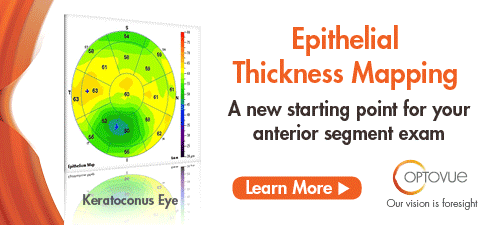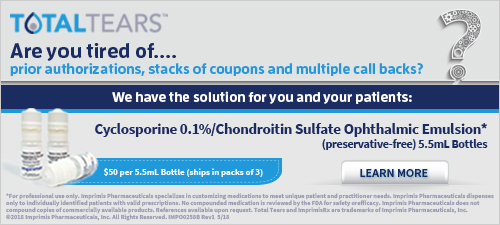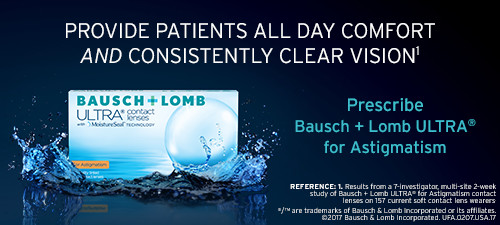
A
weekly e-journal by Art Epstein, OD, FAAO
Off the Cuff: The Meaning of DREAMs
Although things started to quiet down since the release of the Dry Eye Evaluation and Management (DREAM) study, the recent report questioning the health benefits of vitamin supplements hasn’t helped calm patient concerns. Now that I’ve had sufficient time to digest the study and absorb the myriad opinions I’ve heard about it, I wanted to share my thoughts.
|
|||||
|
||||
| Bilateral Acute Angle-closure Glaucoma Induced by Duloxetine | ||||
A 46-year old woman developed bilateral closed-angle glaucoma after 15 days of duloxetine usage. Intraocular pressures (IOP) were 52mm Hg and 55mm Hg in right and left eyes respectively, with shallow anterior chamber and angle closure on gonioscopy. Discontinuing duloxetine treatment, initiation of antiglaucomatous treatment and bilateral Nd:YAG Laser iridotomy obtained normalized IOP and anterior chamber depth. Researchers wrote that duloxetine, used in the treatment of depression, could be responsible for acute angle-closure glaucoma by leading to mydriasis and ciliary effusion. |
||||
SOURCE: Mahmut A, Tunc V, Demiryurek E, et al. Bilateral acute angle-closure glaucoma induced by duloxetine. Ideggyogy Sz. 2017;70(9-10):358-360. |
||||
 |
||
| Increased Risk of Open-angle Glaucoma Among Patients with Diabetes Mellitus: a 10-year Follow-up Nationwide Cohort Study | ||||
This retrospective, propensity score-matched cohort study included patients with diabetes and a matched comparison group from the Korean National Health Insurance Service National Health Screening Cohort, which includes approximately 500,000 adults aged ≥40 years to evaluate the risk of open-angle glaucoma among patients with diabetes. The non-diabetes group was matched to diabetes group in a 1:1 ratio using a propensity score based on age, sex, comorbidities, antihypertensive medication use and medical care visits. Each group was followed from January 1, 2004, to either the date of developing open-angle glaucoma or the date of last follow-up in 2013.
Incidence of open-angle glaucoma was 20/10,000 person-years in diabetes group (n=58,358) and 17/10,000 person-years in non-diabetes group (n=58,358). Age- and sex-adjusted hazard ratio (HR) was 1.19 (95% CI, 1.09 to 1.30). In the subgroup analyses, diabetes was associated with an increased risk of open-angle glaucoma in both younger and older age groups (HR=1.20 for those ages 40 to 59 years, and HR=1.18 for those ages 60 to 79 years), and in both sexes (men, HR=1.13; women, HR=1.27). Investigators determined that patients diagnosed with diabetes were more likely to develop open-angle glaucoma compared with patients without diabetes. |
||||
SOURCE: Rim TH, Lee SY, Bae HW, et al. Increased risk of open-angle glaucoma among patients with diabetes mellitus: a 10-year follow-up nationwide cohort study. Acta Ophthalmol. 2018; Jun 4. [Epub ahead of print]. |
||||
 |
||
| The Prevalence and Characteristics of Chronic Ocular Itch | ||||
In this cross-sectional study, researchers aimed to determine the prevalence and characteristics of chronic ocular itch in an outpatient ophthalmology and optometry clinic. Four hundred patients from an outpatient ophthalmology and optometry clinic were enrolled. The presence and characteristics of chronic ocular itch were assessed by a questionnaire. Data regarding ophthalmologic, dermatologic and systemic conditions as well as current medications were extracted from medical records.
Chronic ocular itch was present in 118 (29.5%) of 400 participants. Chronic ocular pruritus was significantly more prevalent in females [p=0.015; OR=1.8; 95% CI, 1.1 to 2.8] and was significantly associated with the presence of allergic conjunctivitis [51.8% (n=45); p<0.001; OR=5.0; 95% CI, 3 to 8.3], dry eye syndrome [40.1% (75); p<0.001; OR=2.6; 95% CI, 1.7 to 4.1], blepharitis [43.8% (n=21); p=0.021; OR=2.0; 95% CI, 1.1 to 3.8] and atopic dermatitis [50.0% (n=10); p=0.023; OR=2.6; 95% CI, 1.1 to 5.8]. Chronic ocular itch was not significantly associated with systemic conditions or the use of prescribed ophthalmologic medications. Researchers wrote that chronic ocular itch is common and may be related to ophthalmologic or dermatologic pathologies. This study highlighted the importance of identifying and managing this uncomfortable symptom that may negatively impact the quality of life and sleep of affected patients. |
||||
SOURCE: Stull C, Valdes-Rodriguez R, Shafer BM, et al. The prevalence and characteristics of chronic ocular itch: a cross-sectional survey. Itch (Phila). 2017;2(1):e4. |
||||
 |
||
| News & Notes | |
| AllAboutVision.com Makes 100 Popular Articles Available in Spanish AllAboutVision.com now has a library of 100 patient education articles about eye health and vision correction for its Spanish-speaking visitors. The translated articles have generated more than 2.6 million page views so far in 2018. A list of the articles can be found at https://www.allaboutvision.com/es/ However, visitors commonly arrive at their topic of choice via a Google search. Each translated article is also linked from its English counterpart. The translated articles fall into these content areas: • Eye Conditions & Diseases • Contact Lenses • Eyeglasses • Eye Exams • Children’s Vision • Digital Eye Strain • LASIK & Vision Surgery While primarily targeted individuals in the United States for whom Spanish is the first language, the articles have also drawn readership from other Spanish-speaking countries, in particular Mexico and Spain. |
|
| Shire Launches Educational Initiative to Prioritize Eye Health in Screen-saturated World Shire announced the launch of its Screen Responsibly educational initiative focusing on the intersection of screen use and eye health. The initiative is underscored by new, national, Shire-sponsored survey data and the company’s partnership with Thrive Global, a behavior-change media and technology company, to increase a dialogue about caring for the eyes while drawing the benefits of digital devices. Screen Responsibly is an extension of Shire's eyelove campaign to elevate the importance of eye health and raise awareness of the signs and symptoms of chronic dry eye. New survey results from 1,001 adults with self-reported dry eye or dry eye symptoms and 1,000 ophthalmologists and optometrists revealed: • adults reported being more comfortable discussing how much they weigh (41%), the amount of junk food they eat (44%), the time they spend online shopping (51%) and how much they drink on the weekends (55%) than their screen usage; • adults agreed they could not pursue their life passions without screens (70%); and • nearly two-thirds of surveyed eye care professionals reported a rise in eye-related issues that they attribute to screen usage. With intense “screening” being a trigger for dry eye symptoms, Shire is hoping to help consumers adopt more responsible screen habits. Read more. |
|
| Alcon Launches Multifocal Advertising Campaign to Increase Awareness of CL Options, Introduces Social Media Campaign to Educate Cataract Patients on Treatment Options Alcon launched its See Near and Far direct-to-consumer campaign to increase consumer awareness about multifocal contact lens options and encourage them to visit an eye care professional. The campaign will include a television spot that will run on ABC, NBC, CBS and ESPN, among other networks, throughout 2018 and will feature national print and digital media. The campaign aims to reach presbyopes who may already wear reading glasses or who are just starting to experience difficulties with their near vision. The campaign shares how Dailies Total1 Multifocal contact lenses are designed to offer patients clear, comfortable and seamless vision, near and far. Read more. The company is also launching the See What You’re Missing digital campaign to empower people to overcome the “FOMO” (fear of missing out) that can be associated with living with cataracts. The campaign is intended to provide information to help individuals on their journey from cataract diagnosis to treatment. The effort is part of the multi-year MyCataracts educational initiative and will live on the MyCataracts Facebook page. Read more. |
|
| Bausch + Lomb Enrolls First Patient in Envista Mx60ef Trifocal IOL Trial Bausch + Lomb enrolled the first patient in a clinical trial studying the efficacy and safety of an investigational trifocal intraocular lens, the enVista MX60EF, to support an FDA pre-market approval application filing. The single-piece, ultraviolet-absorbing posterior chamber IOL is intended to be used in adults who desire improved uncorrected near, intermediate and distance vision. The lens features StableFlex technology for rapid optic recovery following delivery, an AccuSet haptics offset design, broad contact angle and a SureEdge continuous 360-degree square edge. Read more. |
|
|
|
|
Optometric Physician™ (OP) newsletter is owned and published by Dr. Arthur Epstein. It is distributed by the Review Group, a Division of Jobson Medical Information LLC (JMI), 11 Campus Boulevard, Newtown Square, PA 19073. HOW TO ADVERTISE |


